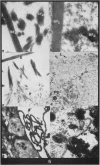Abstract
The release of plasminogen activator from endothelial cells results in the lysis of fibrin-plasminogen clots. The ultrastructural morphology of this process in vitro was examined. Lysis occurred first over the cytoplasm of endothelial cells between the humps formed by the endothelial cell nuclei. The lytic region next became confluent and a condensed zone of fibrin (and possibly adsorbed products of lysis) was seen giving a distinct edge to the fibrin film. The endothelial cells remained relatively intact throughout the process, though there were indications of injury e.g. vesicular blebs were formed on the luminal surface of the endothelium. These were also seen attached to the edge of the fibrin. The edge of the lytic zone was characterized by small dense collections of fibrin fibrils which made a porous rim to the cleared area.
Full text
PDF















Images in this article
Selected References
These references are in PubMed. This may not be the complete list of references from this article.
- Astrup T., Glas P., Kok P. Thromboplastic and fibrinolytic activity in lungs of some mammals. Lab Invest. 1970 May;22(5):381–386. [PubMed] [Google Scholar]
- BULUK K., FURMAN M. On the controlling function of the kidneys in fibrinolysis. Experientia. 1962 Mar 15;18:146–147. doi: 10.1007/BF02153867. [DOI] [PubMed] [Google Scholar]
- CHANDLER A. B. In vitro thrombotic coagulation of the blood; a method for producing a thrombus. Lab Invest. 1958 Mar-Apr;7(2):110–114. [PubMed] [Google Scholar]
- Clarke N., Collins M. Immediate fibrinolytic effect of components from the interior of human cells. Br J Exp Pathol. 1969 Apr;50(2):153–157. [PMC free article] [PubMed] [Google Scholar]
- Constantini R., Spöttl F., Holzknecht F., Braunsteiner H. On the role of the stable plasminogen activator of the venous wall in occlusion induced fibrinolytic state. Thromb Diath Haemorrh. 1969 Dec 31;22(3):544–551. [PubMed] [Google Scholar]
- Gans H., Mori K., Quinlan R., Richter D., Tan B. H. The intestine as a source of plasminogen activator activity. Proc Soc Exp Biol Med. 1971 Feb;136(2):627–629. doi: 10.3181/00379727-136-35327. [DOI] [PubMed] [Google Scholar]
- Gollwitzer R., Karges H. E., Hörmann H., Kühn K. Electron microscopic investigations on soluble and insoluble bovine fibrin. Biochim Biophys Acta. 1970 Jun 23;207(3):445–455. doi: 10.1016/s0005-2795(70)80007-1. [DOI] [PubMed] [Google Scholar]
- Highsmith R. F., Kline D. L. Kidney: primary source of plasminogen after acute depletion in the cat. Science. 1971 Oct 8;174(4005):141–142. doi: 10.1126/science.174.4005.141. [DOI] [PubMed] [Google Scholar]
- Horn R. G., Hawiger J., Collins R. D. Electron microscopy of fibrin-like precipitate formed during the paracoagulation reaction between soluble fibrin monomer complexes and protamine sulphate. Br J Haematol. 1969 Nov;17(5):463–466. doi: 10.1111/j.1365-2141.1969.tb01394.x. [DOI] [PubMed] [Google Scholar]
- Januszko T., Furman M., Buluk K. The kidneys and the liver as the organs regulating the fibrinolytic system of the circulating blood. Thromb Diath Haemorrh. 1966 May 15;15(3):554–560. [PubMed] [Google Scholar]
- KIDD P., DENSON K. W., BIGGS R. THE THROMBOTEST REAGENT AND CHRISTMAS DISEASE. Lancet. 1963 Sep 7;2(7306):522–522. doi: 10.1016/s0140-6736(63)90257-5. [DOI] [PubMed] [Google Scholar]
- MESSER D. L., CELANDER D. R., GUEST M. M. Stability of fibrin contiguous to intima of veins. Circ Res. 1962 Nov;11:832–837. doi: 10.1161/01.res.11.5.832. [DOI] [PubMed] [Google Scholar]
- Pandolfi M. Persistence of fibrinolytic activity in fragments of human veins cultured in vitro. Thromb Diath Haemorrh. 1970 Oct 31;24(1):43–47. [PubMed] [Google Scholar]
- Pugatch E. M., Foster E. A., Macfarlane D. E., Poole J. C. The extraction and separation of activators and inhibitors of fibrinolysis from bovine endothelium and mesothelium. Br J Haematol. 1970 Jun;18(6):669–681. doi: 10.1111/j.1365-2141.1970.tb01592.x. [DOI] [PubMed] [Google Scholar]
- Pugatch E. M., Poole J. C. Studies on the fibrinolytic activity of an extract from vascular endothelium. Q J Exp Physiol Cogn Med Sci. 1969 Jan;54(1):80–84. doi: 10.1113/expphysiol.1969.sp002008. [DOI] [PubMed] [Google Scholar]
- Pugatch E. M., Saunders A. M. A new technique for making häutchen preparations of unfixed aortic endothelium. J Atheroscler Res. 1968 Jul-Aug;8(4):735–738. doi: 10.1016/s0368-1319(68)80032-8. [DOI] [PubMed] [Google Scholar]
- Spurr A. R. A low-viscosity epoxy resin embedding medium for electron microscopy. J Ultrastruct Res. 1969 Jan;26(1):31–43. doi: 10.1016/s0022-5320(69)90033-1. [DOI] [PubMed] [Google Scholar]
- Stewart G. J. An electron microscope study of the polymerization of fibrinogen and its derivatives. Scand J Haematol Suppl. 1971;13:165–178. doi: 10.1111/j.1600-0609.1971.tb02003.x. [DOI] [PubMed] [Google Scholar]
- TODD A. S. Fibrinolysis autographs. Nature. 1958 Feb 15;181(4607):495–496. doi: 10.1038/181495b0. [DOI] [PubMed] [Google Scholar]
- TODD A. S. The histological localisation of fibrinolysin activator. J Pathol Bacteriol. 1959 Jul;78:281–283. doi: 10.1002/path.1700780131. [DOI] [PubMed] [Google Scholar]
- WARREN B. A., BROCK L. G. THE ELECTRON MICROSCOPIC FEATURES AND FIBRINOLYTIC PROPERTIES OF "NEO-INTIMA". Br J Exp Pathol. 1964 Dec;45:612–617. [PMC free article] [PubMed] [Google Scholar]
- WARREN B. A. FIBRINOLYTIC PROPERTIES OF VASCULAR ENDOTHELIUM. Br J Exp Pathol. 1963 Aug;44:365–372. [PMC free article] [PubMed] [Google Scholar]







